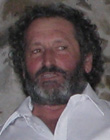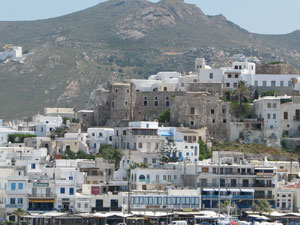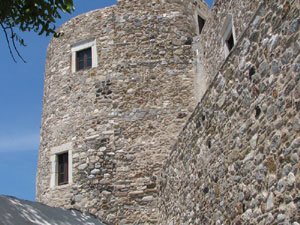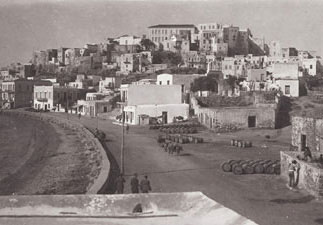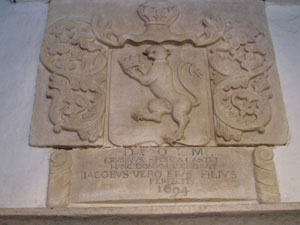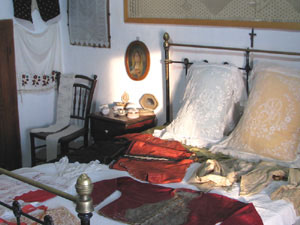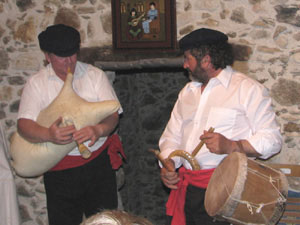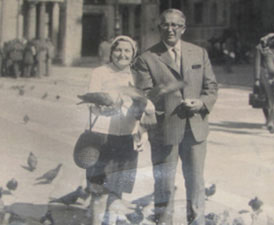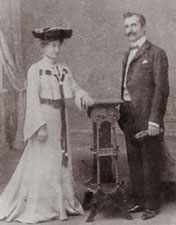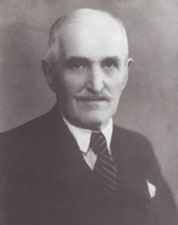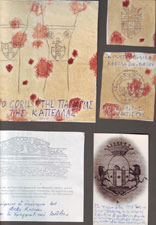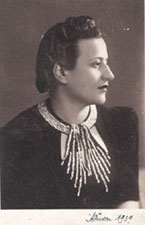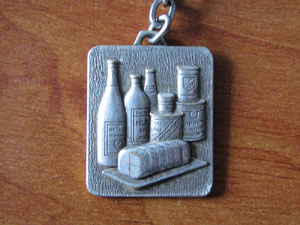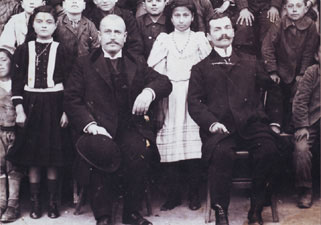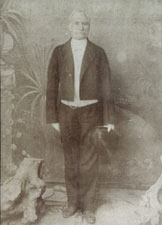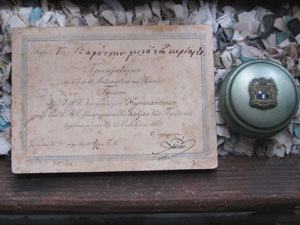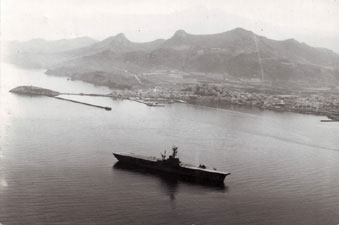Nikolaos Michel Laurent Karavias Della Rocca-Barozzi started in 1998, single-handedly the Venetian Museum of Naxos, Greece, housed in the Della Rocca-Barozzi premises inherited through his mother. This museum is unique in the whole of the Cyclades for a whole range of events covering traditional island song and dance, classical music, jazz and blues evenings, all housed in the acoustically superb basement, helped a lot by the volcanic mortar of the massive walls brought from the island of Santorini, dating from the initial Crusader takeover of the island in 1207. In addition since 1999, the terrace of the residence, which is also the house of Nikolaos Karavias family, hosts for the whole season (April to end of October) the Domus music festival, so prolific in fact that it is now an official entry in the Guinness Book of Records (around 170 concerts annually) - article on the museum in the publication ‘Naxos Life’.
The Venetian Museum houses an eclectic collection of ancestral portraits, family trees, household goods and furnishings of the past. Most of the surrounding houses that are within the Castro complex have front doors topped with the coat of arms of noble Venetian families from that migration 8 centuries ago, and some of these families of aristocracy still live with surnames and a thriving Catholic community. This minority community in the island has always enjoyed good relations with the Orthodox Church, with whom they have historically cooperated to solve issues concerning both groups.
|
View of the Castro of Naxos from the port. |
The Crispi tower within the ancient battlements of the Venetian Castro, the only tower still standing from the original 12. |
The busy Naxos town seafront dating from the 1930s. |
The Della Rocca side of Mr Karavias’s ancestry comes from the Burgundian Othon de la Roche, a Fourth Crusade regimental leader who after the 1204 capture of Constantinople became ruler of the province of Attica in Southern Greece. Mr Karavias still possesses a heirloom displayed: a pearl necklace given by a doge – Dandolo family in Venice - (elected Venetian regional representative) to a Barozzi in Venice, who many generations later, married a Della Rocca (the name got an Italian twist under Venetian influence): a token of thanks for uncovering a murderous plot against the doge. One of the other main strands of Mr Karavias’s ancestry is Barozzi: a family who during the 452 Attila the Hun’s invasion of Italy took refuge like many others on one of the islands of the lagoon that developed into Venice. The Barozzi family one of the 12 important families that participated in the rise and democratisation of Venice and became part of the aristocracy, their descendants still live there and Mr Karavias has visited these distant cousins regularly.
In the Crusaders’ carve-up of the Byzantine Empire, that ironically strengthened the position of the Turks who much later would establish the massive Ottoman Empire, the Cyclades Islands were taken to the Venetian Marco Sanudo in 1207, who was the nephew of the Doge’s family in Venice at the time.
|
The coat-of-arms surmounting one of the inner doors of the Venetian Museum, the ancestral house of the Della Rocca-Barozzi family. |
The interior of a room within the Venetian Museum of Domus Della Rocca-Barozzi. |
Mr Karavias plays the traditional hand carved drum of Naxos and accompanied by a local shepherd playing the local wind instrument, the ‘tzabouna’ - click for video segment here. |
The carve up of the Byzantine Empire was somewhat haphazard and full of political intrigue, and the Aegean Islands were overlooked. The Doge of Venice realizing this encouraged some of his young commanders including Marco Sanudo, who also took part in the assault of Constantinople, that these islands were free to be taken, however if their individually financed expeditions went wrong, they would not receive recognition or support from Venice. Marco Sanudo with a small group of war galleys arrived in the old port of Naxos, however their long-time commercial rivals, the Genoese, were the defenders of the bastion there, and they received support from part of the local Greek population. The attacks by Marco’s men were repulsed and the desponded men of Sanudo expressed their wish for easier pickings, the many undefended islands in the vicinity, before other competition laid claim on those. Sanudo was a wise man and argued in vain that the position and importance of Naxos was unique and it alone would control the Cyclades. He stated he would continue on his own with the siege, but as a goodwill gesture offered to host a final evening dinner and drinks on the coast. At the height of the merriment, an agent of Sanudo went over to the vacant ships, set them all on fire. The attackers were thus stranded, and with options gone the attack was renewed and within 3 days all resistance was ended and in the ferocity the entire city was burnt to the ground. Sanudo’s men then established the new city of Naxos where it is today, taking advantage of the pile of stones that was the ruins of the Classical acropolis, where the present Castro is, and the position of the city facing Paros made it a better controlling point for the area. Thus was founded the Latin (in Greek termed Frank) Duchy of the Aegean Sea that survived till the Ottoman conquest of the islands a few centuries later.
Later Sanudo wanting to increase his power attacked the Byzantine ruled coast of Asia Minor, defeating one of the competing emperors-in-exile, Theodore Lascaris of Nicea. Sanudo so impressed his adversary that he carried off an imperial princess as a bride. The Sanudo dukes (The Cyclades were the longest surviving dukedoms of the Venetian Empire) were succeeded in 1383 by the Crispi dynasty which survived till 1566, when Naxos inevitably fell to the Turks in 1566, who by then were the masters of the Eastern Mediterranean. The Catholic aristocracy of the islands didn’t suffer under their new masters, and the system stayed pretty much the same till these islands were unified with the emerging Greek state in the 1821. Indeed the Catholics although by then Hellenic in language and most customs, enjoyed a degree of French protection, a nation that under the system of capitulations were given this right to protect ‘their’ citizens across the breadth of the Ottoman Empire. This protection was often symbolized with the adornment on public buildings of the ‘fleur-de-lys’ insignia representing the French king, thus the building and its occupants became protected diplomatically under the Ottoman Capitulation system.
|
Parents of Mr Karavias, Dimitris Karavias with Andrée at St Mark’s Square in Venice in the 1960s. |
The 1903 marriage of the maternal grandparents of Mr Karavias, Nikolaos della Rocca (the first pharmacist of Naxos) to Eleonora nee Barozzi. |
Nikolaos Della Rocca, father of Mr Karavias’s mother, c. 1935 |
The coat of arms of the Della Rocca family (left) next to the Sanudos dynasty of Naxos, the clue to why the former family sought refuge in this island post their loss in Greece mainland. |
Through with the capture of Naxos Sanudo believed he was now the master of most of the Cyclades (the northern islands were captured by strong Venetian aristocrats he was not going to contest), this wasn’t the case as some of the islands such as Santorini (Thera) were captured by the Barozzi, and he refused to accept Sanudo’s notion that this was his domain. A fight ensured and eventually Sanudo captured Barozzi in his castle in Santorini, and brought him back as a prisoner to his basement dungeon on Naxos. News travelled fast and within a week there was an order from the Doge of Venice: release Barozzi and apologise for your actions in front of all nobility. This was a difficult pill for Sanudo to swallow, but he had no real choice as the order couldn’t be amended in any way and refusal would mean he would be declared a bandit and all Venice would be against him. Sanudo dressed Barozzi in his finery and seated next to him during Sunday Mass apologised and kissed his hand, allowing him to return to his fiefdom. In the 16th century Turks were gaining the Aegean islands one by one, and it was the turn of Crete. Candia held out for 2 years when all of Crete was under Ottoman subjugation and starvation had killed half the defenders, so Barozzi had to negotiate with the Turks, and gained a promise not to punish the defenders and population and allowing them to leave with their possessions to their galleys. This is when the Barozzis arrived at Naxos, then still under Venetian control. By then the controlling family were the Crispi, and though the Barozzi had money, they couldn’t buy any land, despite pleading for this right – they were in a somewhat vulnerable position. The opportunity to gain a foothold on the island came with a marriage to a daughter from the Crispi family whose dowry included a castle set within olive groves.
The arrival of the De la Roche family (changed later to Della Rocca due to the Venetian influence in this parts) on Naxos followed a different path. Othon de la Roche was the duke of the Southern mainland Greece regions of Attica and Thebes, with their main now ruined castle ‘tour des Francs’ near the Acropolis of Athens. He had married before his arrival in Greece, the French aristocrat Clemenece de Montferrat. For 101 years (till 1308) they were the Dukes of Athens over 4 generations. The third generation of the Della Rocca family married a Byzantine Princess, Elena Angelina Comminos, thus through her dowry increasing considerably his lands to include those of part of Peloponnese (Naplion area). This brought them into conflict with a neighbouring powerful French Catholic dukedom based in the Peloponnese, the Villehardouin [?], ironically already linked through several marriages – thus leading to the foundation to complete claim of this area. The Billardoins were having none of it and the fight to control the area ended with the defeat of the De la Roche family, who lost all, and later on arrived in Naxos as refugees.
|
Margarita Barozzi, niece of mother in Djibouti, running business there - 1939 |
Key ring with the symbols of commerce and address in Djibouti in reverse, a legacy of the Barozzi family when they were one of the main merchants in that African port city. |
Uncle of Mr Karavias’s mother, Michael John Della Rocca on the left seated, teacher in Naxos surrounded by his pupils, dated 1920s. |
On his father’s side Karavias is descended from the redoubtable Cretan Kallergis family, prominent in leading revolts against foreign occupiers. Fleeing after the fall of Crete to the Turks in the 16th century, the forebears were shipwrecked off the island of Ithaka (near Cephalonia - archive views), acquiring the name of Karavias (boat-people from the Greek karavi), when destitute living aboard their beached hulk. Nikalaos’s father Dimitris, had a fine tenor voice and after tuition in Athens, won a Ford foundation grant to study singing in Milan. Pursuing an interest in bear-hunting in the late 1930s, he was in the Northern Greek city of Serres, when his eye was caught by young lady entering the local music school. “Who is she?’ he asked. “Cycladic island Catholic aristocracy,” he was told. “I shall marry her,” he declared, and he eventually did, and what is more, the groom gave up Milan where he was due to move for his studies, went to Naxos and taught singing there for the rest of his life. “He said he never regretted it,” says his son. “On Naxos he was loved and respected. Even the roosters were called Karavias. You heard him singing as he hunted deer on that peninsula over the bay.”
The marriage of Mr Karavias’s parents wasn’t a straightforward matter of a lovematch. At first the parents of the would be bride weren’t at all impressed she declared her love to an Orthodox Greek and an artist which at the time meant a person of limited income and a traveller by necessisty and negative image that went with that, and the age gap between her 19th and 35 year old 'bohemian', this was against centuries of tradition and would not concent. However Miss Andrée della Rocca went into depression, would cry often and would shun food. In desperation of seeing their daughter in this sad state, her parents relented and gave their approval.
Naxos Catholics became strong merchants, possibly assisted through this French protection, had their own ships and placed family relations in distant ports to help their commerce. Members of Nikolaos mother’s fathers’ family were in Constance in Romania and Alexandria [archive postcard views] in Egypt. Industries were tobacco commerce, markets in the port of Djibouti [archive postcard views] in Abyssinia including coffee. The Djibuti connection of the Barozzi family went for more than 60 years, activities finally handed to local people around the 1980s. The Barozzi and Della Rocca family were united in marriage with the grandparents of Nikolaos: Eleonora Barrozzi and Nikolaos Antonios Joseph Della Rocca.
|
Great grandfather, George Barrozzi (maternal grandmother’s father), 1890s, merchant and landowner in Naxos. |
Invitation to Mr Karavias’s great-grand parents to the marriage of the King of Greece. |
Visit in 1973 of a French aircraft carrier to Naxos, a legacy of its historic protection role, a tradition now lost to history. Ironically the Ursuline Catholic School was to close for good a year later. |
Nikolaos has been instrumental in preserving the ancient musical instrument of tzabouna (a goat skin reversed, inflated used in a similar way to a bag-pipe) an instrument dating from pre-history and until recently only performed by a handful of shepherds of the island: now with the collaboration of Mr Karavias’s, there is a mini-school training a new generation. In addition Mr Karavias has over the years campaigned for the preservation of the environment of Naxos, sometimes involving the confrontation of big business wishing to develop major tourist resorts which aimed to close off beaches to the general public; these were thwarted. As part of his wish to remedy at least a tiny part of the Second World War bombing damage the island suffered, Mr Karavias has started in 2007 the initial stage of reconstructing a house neighbouring the Castro (hover here - shown in red arrow in this archive photo) and hopes this will be an inspiration to others in remedying these losses including the nearby forests that were burnt through the bombardment raids of the RAF in 1945, a result of false intelligence.
Naxos still has a diminished but thriving Catholic community of around 100 persons including the surviving names of Della Rocca, Marcopoli, Fornaro, Marangos, Prindezis, Remoundos etc. The eldest of the community is the 1909 born Michael Marangos. Though there are descendants, there aren’t any people on the island carrying the Crispi or Sommaripa names. The last Barozzi name holder is Louisa, married to an Englishman, who is Nikolaos’s aunt living in England. The Naxos Catholic community is ministered by Father Emmanuel Remoundos, born and brought up in Naxos but family origin of the nearby island of Tinos.
Notes: 1- There is an online viewable detailed study of the Venetian colonial history of the nearby Cycladic Island of Sifnos entitled ‘Venetian Colonialism in the Aegean: Sifnos in the Thirteenth Century - Eleni Mahaira-Odoni, 2007’, and no doubt there were many similarities in the story of this period with that of Naxos, to which there are many references.
2- Another study of note concerning the Latin history of the region is the book ‘Archipelagus Turbatus - Les Cyclades entre colonisation latine et occupation ottomane c. 1500-1718, B.J. Slot, 1982’.
3- An external article covering Mr Karavias and some relations on the island.
Mr Karavias as his position and heritage naturally provides, is the holder of a considerable volume of archive documents (and some rare books) concerning the history of Naxos and surroundings. These files have been partly examined, but never published due to the time constraints of Mr Karavias’s many commitments. Of further interest to potential researchers is the collection of books in the hands of Mr Karavias written in Greek in Latin characters, called Francochiotika - Greek written in Latin characters, very much used by the Levantines during the XIXth century. This now extinct hybrid style was not just for recipes etc. but a vehicle for the priesthood to reach to the local French educated community in a Greek setting. If any readers would like to collaborate or sponsor the further research in this neglected field he would be most willing to hear from potential collaborators to discuss the matter further, through this e-mail: venetianmuseum[at]yahoo.gr.
 interview date 2008-9
interview date 2008-9 |
 interview date 2008-9
interview date 2008-9